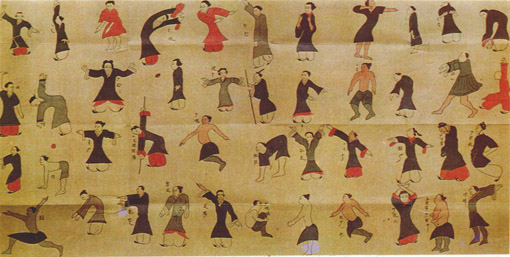
During the 4000-5000years development of Chinese Qigong, many valuable Daoyin pictures have been made. For example, the Daoyin Picture excavated from Ma Wang Dui, the Daoyin Picture for Keeping in Good Health drawn by Tao Hongjing, The Daoyin Picture and Daoxing Picture in Sui Shu Jing Ji Zhi, the Daoyin Picture for Six qi and the Huangting Daoyin Picture for Internal Organs in the Chong Wen Shu Mu, and the Daoyin Picture of Celestial Being in Wan Shou Xian Shu, and so on. However, for Health Qigong, the most valuable one among the Daoyin pictures must be the Daoyin Picture excavated from Ma Wang Dui No. 3 Tombs of the Han Dynasty on the outskirts of Changsha city in Hunan province in 1973. It is the oldest existing Qigong Daoyin picture so far. When excavated from the site, it was very broken. There was no signature of the painter, no legend, and on name of the picture on it. The present picture name is given on the basis on its contents after the picture was repaired. The length and the height of original picture are 100 cm and 50cm respectively. The whole picture consists of over 40 Daoyin pictures which are divided into four sets. Some of the pictures have words on it concerning the movements, breathing and illness treatments involved in the pictures; some others contain people holding instruments in their hands on it. According to research, the tomb owner of Ma Wang Dui No. 3 Tombs of the Han Dynasty is the son of Changsha city governor of that time. He died and buried in 168 BC in the Han dynasty. A detailed interpretation of the picture can help us understanding the development of Qigong in the Han dynasty and the general situation before that.
The Meaning of Daoyin
The Chinese character “Dao” has the same meaning with “Yin”, and it originally means “to lead something with hands”. Therefore in Shuo Wen Jie Zi, it says that “Dao has the same meaning with Yin.” However, the original meaning of “Yin” is to open the bow, which is also explained in Shuo Wen Jie Zi,. As a phrase, “Daoyin” means “to lead the way”; while as a way to keep in good health, it means “to guide qi and stretch the body”, namely what we means by Health Qigong. “Daoyin” can be understood in both broad and narrow senses. In the broad sense, it refers to the whole Qigong methods including active course method and quiet course method. Therefore, Guo Moruo pointed out in his Slavery Era that, “ What means by Daoyin in the ancient time is actually what we call Qigong nowadays.” In the narrow sense, Daoyin just means the active course method of Qigong; that is what it means by “to shake your bone and muscles, and move your arms and legs” by Wang Bingzhi in the Complement of the Medical Classic of the Yellow Emperor Su Wen. Obviously, no matter the bare-hand exercises or the exercises with instruments in the picture, they all refer to the Daoyin in the narrow sense. Although we cannot see very clear the specific Daoyin methods (movements) in the picture, we can still know from the analysis of the body movements that the whole picture cannot be a whole set of Daoyin method, but several scenes about Daoyin exercises. When compared with the “Dancing” pictures on the painted-pottery pot, the movements in this picture are various, especially the exercises with instruments and the imitating exercises. Thought scenes about Daoyin exercises with instruments are limited and unclear, the exercises with sticks are relatively easy to recognize. According to experts’ analyses, although they are rare, exercises with plates, balls, and bags exist. In the opinion of the author, being related with various martial arts could be one of the main bases of Health Qigong•Taichi Stick Exercise for Keeping Health. The imitating Daoyin refers to that when taking Daoyin exercises, exercisers need to imitate the movements of some animals. This is one of important points needed to be reflected in the titles of the picture. North is the original character for back in Chinese and zhan means bird of prey in ancient time of China. That is to say, the titles on the Daoyin Picture are named on the basis of the animals and their movements features. Exercisers can developed more movements for themselves on the basis of those original movements in the picture. The earliest literature recording the imitating exercises and their functions is Zhuang Zi. In the chapter named Ke Yi, it says that “to inhale fresh air and exhale dirty air to keep healthy and to imitate the behavior of animals and birds to elongate life, this is so called Daoyin Yang Sheng Shu which is greatly enjoyed by Mr. Peng Zu Shou.”, which indicates that combining with the body movements of animals such as bears and birds, this kind of breathing exercises has the function of prolonging life. Therefore, it is favored by people who love Daoyin and keeping in good health like Peng Zu. The book Hui Nan Zi • Jing Shen Xun supplements the above record with four other movements, making it better. It is inferred that Wu Qin Xi, which is praised as the originator of sets of imitating active course methods, is created on the basis of these imitating exercises by the famous Chinese physician Hua Tuo, with a combination of his own observation and experiences. To some extent, it is believed that the “Wu Qin Xi” in the pre-Hua Tuo Period is the originator of the Health Qigong•Ma Wang Dui Daoyin.
(By Huang Jian)

